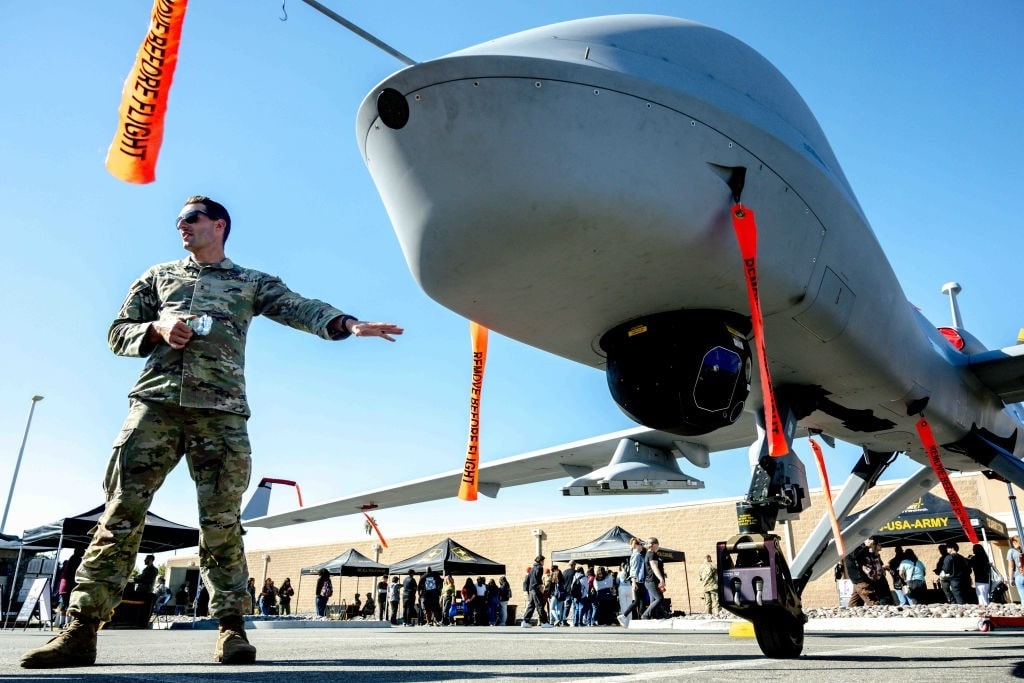When Deputy Secretary of Defense Kathleen Hicks announced the Replicator Initiative in August, it generated a great deal of enthusiasm in the Pentagon and industry. The program to develop and acquire thousands of weaponized drones was not limited to land, sea, or air, but would include all domains. Four months later, the buzz has gone silent.
In its report “Drones – Is the DOD Just Chasing the Next Shiny Thing?” Liberty Nation described the Replicator scheme as an attempt by the Department of Defense to develop a mass of remotely controlled weapons:
“That is not simply cutting-edge technology in bombers, expensive cruise missiles, warships, and generation-plus fighter aircraft, but swarms of small, less costly drones in all warfighting domains.”
The intention was to overwhelm Chinese Navy and Air Force defenses. “Replicator is meant to help us overcome the [People’s Republic of China’s] biggest advantage, which is mass. More ships. More missiles. More people,” Hicks said, adding the US would counter this “with mass of our own, but ours will be harder to plan for, harder to hit, harder to beat.” According to DOD News, she touted America’s “real comparative advantage” as “the innovation and spirit of our people.”
An Idea Without a Plan
 Most listeners to the deputy secretary’s presentation assumed there was an acquisition strategy and plan that would turn those ambitious words into reality. Alas, such was not the case. In a recent meeting between Hicks and industry representatives, the gap between what the Department of Defense wants to do and what it can do became widely apparent. “Four months later, no one seems to be able to explain the plan or how the Pentagon will pay for it. Frustrations over that lack of clarity came to a head on Dec. 12, when nine leaders from tech companies and several high-ranking DOD officials, including [Hicks] gathered for a meeting about the program,” Matt Berg wrote for Politico.
Most listeners to the deputy secretary’s presentation assumed there was an acquisition strategy and plan that would turn those ambitious words into reality. Alas, such was not the case. In a recent meeting between Hicks and industry representatives, the gap between what the Department of Defense wants to do and what it can do became widely apparent. “Four months later, no one seems to be able to explain the plan or how the Pentagon will pay for it. Frustrations over that lack of clarity came to a head on Dec. 12, when nine leaders from tech companies and several high-ranking DOD officials, including [Hicks] gathered for a meeting about the program,” Matt Berg wrote for Politico.
Industry representatives were no doubt dismayed to find out that no funding had been authorized or appropriated for the Replicator program. Without an acquisition strategy or plan for how Replicator will be funded, there will not likely be a line-item number where Congress can put money. Other problems included the lack of an operational concept for how the various unmanned systems would be integrated into the battlespace.
Explanation Not Satisfying
According to the Politico article, Hicks stated, “The reality is, Replicator is removing kinks in the hose of the system that is innovation in DoD … There are a multitude of programs that already exist in the department that need help to get from where they are to deliver at scale. That is where Replicator is focused. It’s not a program. It’s a process for improving our ability to scale.” If you do not find that explanation clear, you are not alone. After the private meeting, participants called the idea “disorganized and confusing.”
Developing a program as complex and far-reaching as the one Hicks described in August requires a significant understanding of how the systems will be used. How will these unmanned weapons be integrated with manned and existing systems? How will the drones deal with a contested environment where the enemy has a say? What does the command, control, and communications architecture look like? How many vendors does the DOD anticipate, and how will the production and fielding of thousands of these drones be coordinated so that they reach the battlefield and are employed in an effective manner?
For example, the Air Force is developing an unmanned system called Collaborative Combat Aircraft (CCA), or drone wingmen. It has a program of record with an acquisition strategy. An Air Force spokesman told Breaking Defense, “The CCA acquisition strategy relies upon incremental development, continuous competition with multiple vendors, full-scale prototypes, and speed-to-ramp with available technologies to enable accelerated learning and fielding.” So far, the Replicator program has not achieved anything close to this level of development.
Replicator is not the first defense program that looked good in PowerPoint but couldn’t be justified in the real world. The death knell for Replicator, however, was Hicks’ statement that the money would come from existing, already-funded military programs across the Defense Department. Sure, it will. Tell that to the congressman whose pet program the department would be robbing.
The views expressed are those of the author and not of any other affiliation.




